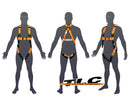A fall from any height can leave an employee with permanent and debilitating injuries. From only one metre, serious injuries like fractures, spinal cord injuries, concussions and brain damage can occur. At any height over two metres, the risk of serious injury or death increases insignificantly.
Falls can happen in any industry, however they seem to be most prevalent in the following:
- Construction
- Manufacturing
- Community services
- Trade
- Communication
- Transport and storage
If you’re involved in any of the industries mentioned above, you need to be extra vigilant when it comes to height safety.
You might think fatalities are extremely rare, but during the June 2003 to June 2011, 232 workers lost their lives after falling from a height at work. The fact of the matter is it happens and as an employer, you need to be responsible for the safety of your workers.
Falls on the work site can have a disastrous impact on the lifestyle of the victim and on the morale of your team. It can also negatively impact the profitability of your business through lost working time and worker’s compensation. It pays in more ways than one to practice safety when working from heights and it’s what we are going to explore in this blog.
Training
If your business operations require work that is performed at a height, you really should have people in your team trained in the skills and knowledge to work safely at heights. That state and federal governments provide comprehensive units in training in this area.
Planning
Before you even set foot onto a site, the person responsible for occupational health and safety needs to make an inspection of the layout, checking the condition of structures, potential hazards, required equipment and weather conditions.
This can help them plan accordingly (and redesign if necessary) so they are complying with OHS requirements.
During the planning phase, all the safety equipment needs to be check for serviceability. If equipment is faulty, replace it immediately with qualified products from a reputable retailer.
Before work commences, the worksite needs to be managed in a way to reduce any risk. This could mean the installation of fall protection and perimeter protection equipment, or working how to how safely move tools and equipment around in the work area.
Working From Heights
Even though there it will be the responsibility of certified peoples on your team to look for and eliminate any hazards, it’s prudent to have a work culture where everyone keeps their eyes open.
If everyone is encouraged to be wary of hazards like loose wires, slippery surfaces, tools that are not secured and malfunctioning equipment, you’re more like to identify risks and introduce measures or change work practices to ensure that all employees leave at the end of the day the way they arrived at work – healthy and injury free.
For more information relating to fall prevention, there is a great guide by Worksafe Victoria that we suggest you look at.



